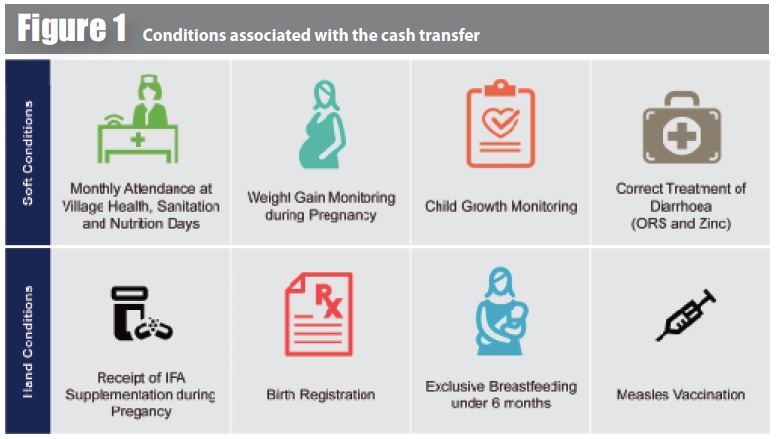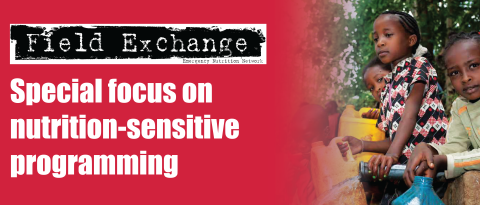Impact of a homestead food production programme on household and child nutrition in Cambodi
Summary of research1
Location: Cambodia
What we know: Food-based strategies such as homestead food production have the potential to increase micronutrient intake and improve the health and nutritional status of women and children.
What this article adds: Cambodia’s homestead food production programme increased household production and consumption of micronutrient-rich foods and maternal and child intake of some foods but did not significantly improve maternal/child anthropometry or anaemia. Lack of nutrition/health impact may be due to other factors such as limitations regarding the dietary diversity indicator to reflect micronutrient intake; care practices and illness; programme and evaluation designs; and targeting. Using programme impact pathways to plan M&Emonitoring and evaluation would greatly strengthen the quality of evidence.
 As food prices increase, poor households are usually forced to cut back their consumption of high-quality foods such as fruits, vegetables, dairy products, eggs and meat to protect their consumption of calories from staple foods. This in turn can substantially decrease their already marginal consumption of micronutrients such as vitamin A, zinc and iron, which are essential for optimal health and development. Women and young children, who have particularly high requirements of several micronutrients for growth and reproduction, are particularly susceptible to the negative effects of micronutrient malnutrition. Food-based strategies such as homestead food production have the potential to increase micronutrient intake and improve the health and nutritional status of women and children through various pathways, including increased household production for own consumption, increased income from the sale of products, and improved social status of women through greater control over resources.
As food prices increase, poor households are usually forced to cut back their consumption of high-quality foods such as fruits, vegetables, dairy products, eggs and meat to protect their consumption of calories from staple foods. This in turn can substantially decrease their already marginal consumption of micronutrients such as vitamin A, zinc and iron, which are essential for optimal health and development. Women and young children, who have particularly high requirements of several micronutrients for growth and reproduction, are particularly susceptible to the negative effects of micronutrient malnutrition. Food-based strategies such as homestead food production have the potential to increase micronutrient intake and improve the health and nutritional status of women and children through various pathways, including increased household production for own consumption, increased income from the sale of products, and improved social status of women through greater control over resources.
In this paper, the authors examine the results of an evaluation of a homestead food production programme in Cambodia that was supported by Helen Keller International (HKI) between October 2005 and May 2007. The programme works with local non-governmental organisations (NGOs) to create village model farms that serve as distribution points for seeds, seedlings, saplings, poultry and animals and as training centres for homestead food production activities and nutrition education. Women are the primary recipients and receive homestead food production inputs, training in homestead food production activities and nutrition education. Each village model farm typically serves about 40 households which are divided into two groups of about 20 women each. Each group appoints a leader who is responsible for organising monthly meetings for the purposes of distributing homestead food production inputs, training and nutrition education. The homestead food production programme presented in this paper operated in one province in Cambodia with 35 village model farms serving 1,400 households.
The aim of this study was to evaluate the impact of the homestead food production programme in Cambodia on household production and consumption of micronutrient-rich foods and on maternal and child health and nutrition (intake of micronutrient-rich foods, anthropometry, haemoglobin and anaemia prevalence); and to assess pathways of impact on maternal and child health and nutrition.
Methods
HKI employed two cross-sectional surveys, one at baseline (October 2005) and another at endline (May 2007). Both surveys used a precoded, structured questionnaire that included questions about food production, food consumption and income from homestead food production along with socioeconomic and demographic indicators and maternal and child intake of micronutrient-rich foods. Each survey included 500 households, consisting of 300 households that participated in the intervention and 200 control households. Analysis of results was carried out using t-tests and chi-square tests. Using endline data and multivariate analyses, the authors examined the pathways of impact of the programme on maternal and child health and nutrition.
Results
Intervention and control households were similar at baseline in sociodemographic characteristics, but more intervention households owned animals, earned income from homestead food production and produced and consumed micronutrient-rich foods. At endline, some of these differences had widened with more vegetables produced and dark-green leafy vegetables, yellow and orange fruits and eggs consumed; greater household dietary diversity; and lower prevalence of fever amongst children (all significant). The frequency of consumption of some micronutrient-rich foods was higher among mothers in the intervention group compared to the control group at endline, although there was no significant difference in dietary diversity score between the two groups. There were no other differences between the groups in maternal and child health and nutrition. Greater household production of fruits and vegetables was associated with greater household dietary diversity, which was associated with dietary diversity among mothers and children. However, dietary diversity was not associated with other maternal and child health and nutrition outcomes.
Discussion
The authors propose that the lack of evidence of impact on maternal or child anthropometric measures or anaemia prevalence in this study may indicate that dietary diversity is not a useful indicator of micronutrient intake in this population if the quantities consumed are too small and micronutrient and/or energy intakes continue to be limiting. However, it is also possible that the potential impact that increasing dietary diversity may have on improving health and nutrition outcomes could be diluted by other factors, such as illness and suboptimal care and feeding practices.
Irrespective of whether or not dietary diversity is a useful indicator, the authors suggest that the lack of evidence of such impact may indicate programme design issues associated with a true lack of effect and/or weaknesses in the evaluation that precluded observing any impact on nutrition. With regards to the first, results of the study point to the need to focus on improvements in particular components of the homestead production programme. Examples include small-animal production and effective behaviour change communication to promote adoption of optimal nutrition and health practices, e.g. greater use of animal source foods; intra-household allocation of resources; traditional care and feeding practices; food preferences; and determinants of access to, and use of, health care and services. The programme should also focus its health and nutrition intervention package on children under two years of age as the critical window, rather than on the under-fives. Other potential programme consequences to explore include altered disease exposures from different agricultural practices (e.g. zoonotic diseases) and water management (e.g. irrigation and malaria);, changes in women’s time allocation, ; the importance of proximity to home and children for women involved in agricultural production, ; and the changing roles and intra-household dynamics resulting from women’s acquiring greater access to resources.
The authors also assert that the evaluation design for Cambodia’s homestead food production programme could be improved. Weaknesses in the evaluation design include lack of comparability between groups at baseline, ; failure to control for self-selection of households into the intervention, ; and collection of baseline and endline data during different seasons. A better- designed evaluation could address issues of adequacy and plausibility and could provide relatively strong evidence of a programme’s impact. In addition, the use of a programme theory framework may be useful in identifying and analysing programme impact pathways, to help reveal how impact is achieved, to help design an effective monitoring and evaluation strategy, and to generate information to contribute to a stronger evidence base of programme impacts.
Conclusions
Cambodia’s homestead food production programme increased household production and consumption of micronutrient-rich foods and maternal and child intake (or frequency of intake) of some foods. However, household-level benefits from the programme did not translate into significant improvements in maternal and child health and nutrition. Weaknesses in the evaluation design prevent drawing firm conclusions about the programme impacts. The authors conclude that a careful redesign and rigorous assessment of the programme using a programme theory framework would help realise its true potential to improve maternal and child health and nutrition outcomes.
Footnotes
1 Olney, D. K., Talukder, A., Lannotti, L.L., Ruel, M.T., and Quinnood, V. (2009). Assessing impact and impact pathways of a homestead food production program on household and child nutrition in Cambodia. Food and Nutrition Bulletin, Vol. 30 (4): 355-69.


